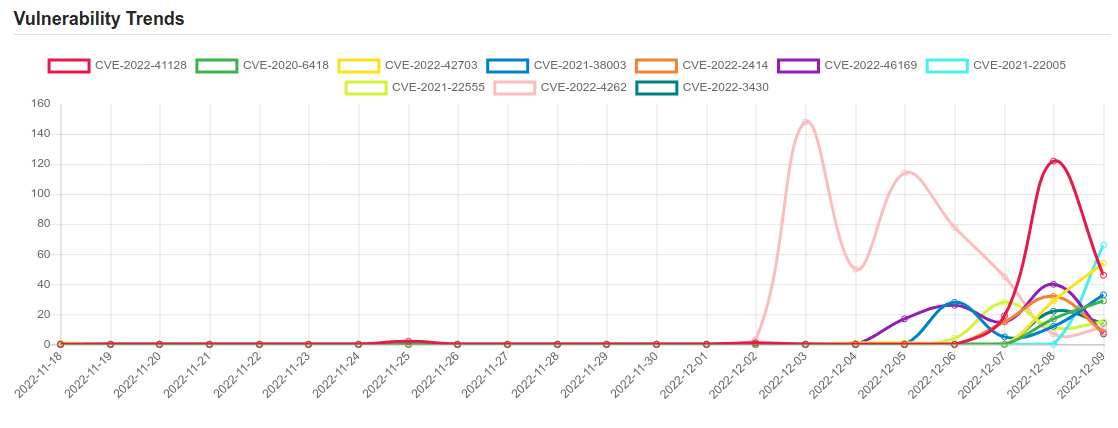Daily Vulnerability Trends: Sat Dec 10 2022

| CVE NAME | CVE Description |
| CVE-2022-41717 | An attacker can cause excessive memory growth in a Go server accepting HTTP/2 requests. HTTP/2 server connections contain a cache of HTTP header keys sent by the client. While the total number of entries in this cache is capped, an attacker sending very large keys can cause the server to allocate approximately 64 MiB per open connection. |
| CVE-2022-33942 | Protection mechanism failure in the Intel(R) DCM software before version 5.0 may allow an unauthenticated user to potentially enable escalation of privilege via adjacent access. |
| CVE-2021-26708 | A local privilege escalation was discovered in the Linux kernel before 5.10.13. Multiple race conditions in the AF_VSOCK implementation are caused by wrong locking in net/vmw_vsock/af_vsock.c. The race conditions were implicitly introduced in the commits that added VSOCK multi-transport support. |
| CVE-2022-23494 | tinymce is an open source rich text editor. A cross-site scripting (XSS) vulnerability was discovered in the alert and confirm dialogs when these dialogs were provided with malicious HTML content. This can occur in plugins that use the alert or confirm dialogs, such as in the `image` plugin, which presents these dialogs when certain errors occur. The vulnerability allowed arbitrary JavaScript execution when an alert presented in the TinyMCE UI for the current user. This vulnerability has been patched in TinyMCE 5.10.7 and TinyMCE 6.3.1 by ensuring HTML sanitization was still performed after unwrapping invalid elements. Users are advised to upgrade to either 5.10.7 or 6.3.1. Users unable to upgrade may ensure the the `images_upload_handler` returns a valid value as per the images_upload_handler documentation. |
| CVE-2022-29596 | MicroStrategy Enterprise Manager 2022 allows authentication bypass by triggering a login failure and then entering the Uid=/../../../../../../../../../../../windows/win.ini%00.jpg&Pwd=_any_password_&ConnMode=1&3054=Login substring for directory traversal. |
| CVE-2022-3602 | A buffer overrun can be triggered in X.509 certificate verification, specifically in name constraint checking. Note that this occurs after certificate chain signature verification and requires either a CA to have signed the malicious certificate or for the application to continue certificate verification despite failure to construct a path to a trusted issuer. An attacker can craft a malicious email address to overflow four attacker-controlled bytes on the stack. This buffer overflow could result in a crash (causing a denial of service) or potentially remote code execution. Many platforms implement stack overflow protections which would mitigate against the risk of remote code execution. The risk may be further mitigated based on stack layout for any given platform/compiler. Pre-announcements of CVE-2022-3602 described this issue as CRITICAL. Further analysis based on some of the mitigating factors described above have led this to be downgraded to HIGH. Users are still encouraged to upgrade to a new version as soon as possible. In a TLS client, this can be triggered by connecting to a malicious server. In a TLS server, this can be triggered if the server requests client authentication and a malicious client connects. Fixed in OpenSSL 3.0.7 (Affected 3.0.0,3.0.1,3.0.2,3.0.3,3.0.4,3.0.5,3.0.6). |
| CVE-2022-25765 | The package pdfkit from 0.0.0 are vulnerable to Command Injection where the URL is not properly sanitized. |
| CVE-2022-41128 | Windows Scripting Languages Remote Code Execution Vulnerability. This CVE ID is unique from CVE-2022-41118. |
| CVE-2020-6418 | Type confusion in V8 in Google Chrome prior to 80.0.3987.122 allowed a remote attacker to potentially exploit heap corruption via a crafted HTML page. |
| CVE-2022-42703 | mm/rmap.c in the Linux kernel before 5.19.7 has a use-after-free related to leaf anon_vma double reuse. |
| CVE-2021-38003 | Inappropriate implementation in V8 in Google Chrome prior to 95.0.4638.69 allowed a remote attacker to potentially exploit heap corruption via a crafted HTML page. |
| CVE-2022-2414 | Access to external entities when parsing XML documents can lead to XML external entity (XXE) attacks. This flaw allows a remote attacker to potentially retrieve the content of arbitrary files by sending specially crafted HTTP requests. |
| CVE-2022-46169 | Cacti is an open source platform which provides a robust and extensible operational monitoring and fault management framework for users. In affected versions a command injection vulnerability allows an unauthenticated user to execute arbitrary code on a server running Cacti, if a specific data source was selected for any monitored device. The vulnerability resides in the `remote_agent.php` file. This file can be accessed without authentication. This function retrieves the IP address of the client via `get_client_addr` and resolves this IP address to the corresponding hostname via `gethostbyaddr`. After this, it is verified that an entry within the `poller` table exists, where the hostname corresponds to the resolved hostname. If such an entry was found, the function returns `true` and the client is authorized. This authorization can be bypassed due to the implementation of the `get_client_addr` function. The function is defined in the file `lib/functions.php` and checks serval `$_SERVER` variables to determine the IP address of the client. The variables beginning with `HTTP_` can be arbitrarily set by an attacker. Since there is a default entry in the `poller` table with the hostname of the server running Cacti, an attacker can bypass the authentication e.g. by providing the header `Forwarded-For: |
| CVE-2021-22005 | The vCenter Server contains an arbitrary file upload vulnerability in the Analytics service. A malicious actor with network access to port 443 on vCenter Server may exploit this issue to execute code on vCenter Server by uploading a specially crafted file. |
| CVE-2021-22555 | A heap out-of-bounds write affecting Linux since v2.6.19-rc1 was discovered in net/netfilter/x_tables.c. This allows an attacker to gain privileges or cause a DoS (via heap memory corruption) through user name space |
| CVE-2022-4262 | Type confusion in V8 in Google Chrome prior to 108.0.5359.94 allowed a remote attacker to potentially exploit heap corruption via a crafted HTML page. (Chromium security severity: High) |
| CVE-2022-3430 | No description provided |
| CVE-2022-3431 | No description provided |
| CVE-2022-20968 | No description provided |
| CVE-2022-3786 | A buffer overrun can be triggered in X.509 certificate verification, specifically in name constraint checking. Note that this occurs after certificate chain signature verification and requires either a CA to have signed a malicious certificate or for an application to continue certificate verification despite failure to construct a path to a trusted issuer. An attacker can craft a malicious email address in a certificate to overflow an arbitrary number of bytes containing the `.’ character (decimal 46) on the stack. This buffer overflow could result in a crash (causing a denial of service). In a TLS client, this can be triggered by connecting to a malicious server. In a TLS server, this can be triggered if the server requests client authentication and a malicious client connects. |
A considerable amount of time and effort goes into maintaining this website, creating backend automation and creating new features and content for you to make actionable intelligence decisions. Everyone that supports the site helps enable new functionality.
If you like the site, please support us on Patreon using the button below

To keep up to date follow us on the below channels.




![[RALORD] - Ransomware Victim: agromate company 6 image](https://www.redpacketsecurity.com/wp-content/uploads/2024/09/image-300x300.png)
